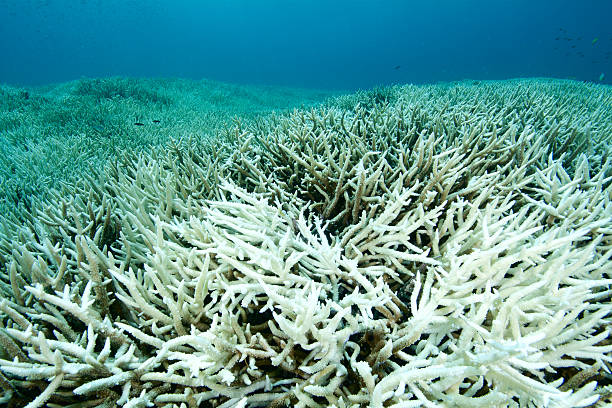
devastating coral bleaching due to global warming. These corals are dying.
Browse 2,600+ coral bleaching stock photos and images available, or search for coral bleaching australia to find more great stock photos and pictures.

devastating coral bleaching due to global warming. These corals are dying.

Underwater photo of coral bleaching and hard coral Acropora sp turns white due to high sea surface temperature and climate change
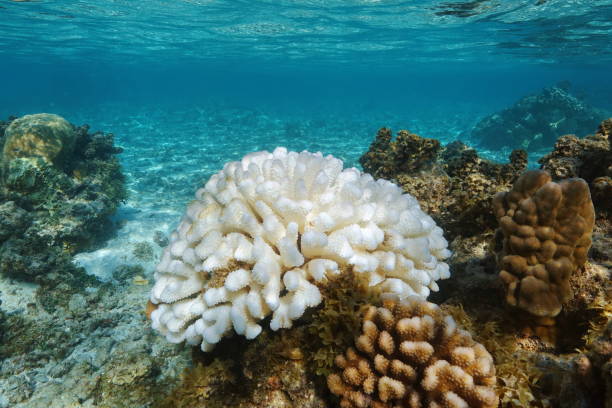
Pocillopora coral bleached due to El Nino in the Pacific ocean, Polynesia, American Samoa

Underwater photo from a scuba dive
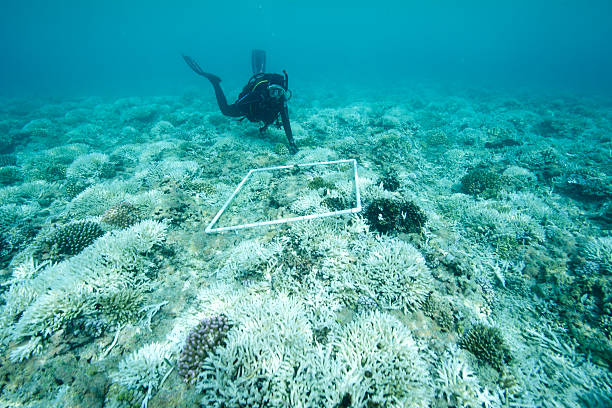
coral reef bleached by global warming is being surveyed by marine biologist

marine biologist measures a bleached coral underwater

Coral bleaching occurs when corals expel their symbiotic algae, known as zooxanthellae, due to stress caused by factors such as high water temperatures, pollution, or ocean acidification. This leads to the corals losing their vibrant colors and becoming pale or white. Without the zooxanthellae, the corals are more vulnerable to disease and may ultimately die. Coral bleaching is a major concern for coral reefs around the world, as it can have a devastating impact on the entire marine ecosystem that relies on these important structures.

A coral is bleaching in Indonesia. What is causing the bleaching in this case is unknown.

Coral reefs are the one of earths most complex ecosystems, containing over 800 species of corals and one million animal and plant species. Here we see a shallow coral reef with a Finger coral (Stylophora pistillata) that is completely bleached white. Coral bleaching occurs when corals are distressed and dying due to the ocean temperature rising. This stress causes them to expel endosymbiotic algae leaving only the dead skeleton. Image obtained whilst scuba diving at Phi Phi, Krabi province, Thailand.

Coral bleaching of Acropora hard corals - process when corals become white due to loss of symbiotic algae and photosynthetic pigments caused by higher ocean water temperature. Global warming impact.

marine biologist studies the coral reef

A coral colony has bleached due to high sea temperatures near Flores, Indonesia. This tropical region harbors extraordinary marine biodiversity.

Hard corals bleaching due to high water temperature

Coral bleaching process with healthy, stressed and bleached stages outline diagram. Labeled educational scheme with ecosystem problem and ocean warming dangers for fauna color vector illustration.

Coral reef underwater view in Raja Ampat, West Papua, Indonesia

Part of staghorn coral bleaching caused by sea water thermal rising due to climate change and global warming. Coral colony turn to white from excessive seawater temperature can lead to coral mortality

mass death of coral due to global warming

Bleached Acropora coral in shallow water, due to El Nino, Pacific ocean, French Polynesia

split level image of coral reef in foreground and tropical island background in seychelles

This Staghorn coral ((Acropora cervicornis) is suffering partial coral bleaching as the extremities are turning white. A critically endangered species of coral highly sensitive to pollution, climate change, ocean acidification and disease. Location is Phi Phi Islands, Andaman Sea, Krabi, Thailand.

marine biologist studies the effects if coral bleaching on a reef in the seychelles

White color of hard corals is coral bleaching. The main cause of coral bleaching is heat stress.

Corals begin to bleach due to high water temperatures in shallow water amid the remote islands of Raja Ampat, Indonesia. This equatorial region is possibly the center for marine biodiversity.

The devastating effects of Coral bleaching as a result of Climate Change. These corals are dead due to the ocean temperature rising and causing loss of endosymbiotic algae. This once was a garden of healthy coral. Now this coral reef ecosystem is decimated leaving nothing but rubble. Footage taken whilst scuba diving at Phi Phi islands, Krabi province, Thailand.
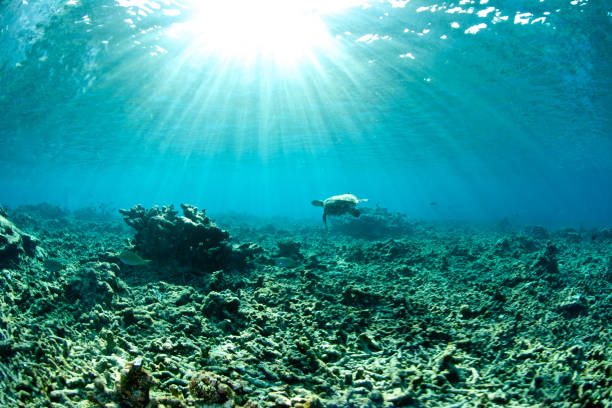
lone turtle swims barren coral reef damaged by coral bleaching caused by global warming

The color of Gorgonian Seafan Annella mollis varies and ranges from cream-colored to pink and orange. The close-meshed skeleton of the species in the family Subergorgiidae consists of fused sclerites and gorgonin, so it is extraordinarily flexible and thus perfectly adapted to strong currents. This white specimen, unusual for that region, is bleached. A lot of small fishes, mainly Anthias and Damselfishes are there. Palau, Micronesia, 6°59'10.52 N 134°13'7.34 E at 32m depth

beautiful coral and very clear ocean

Clark's anemone fish in a bleached anemone

Women's teeth whitening close-up before and after the procedure. Upper and lower jaw. Dental clinic patient. Isolated on white background. Oral care. Dental treatment.

This image shows the effects of Coral bleaching and disease. This stunning Staghorn coral (Acropora) is beginning to show the signs of coral bleaching. The tips are turning white. This could be as a result of pollution, disease or global warming. The location is Phi Phi Islands, Andaman Sea, Krabi, Thailand.

This Table coral (Acropora cytherea) is showing signs of coral bleaching and disease. The brown parts are healthy, the white parts are where the coral has expelled its healthy symbiotic algae leaving only the animal exoskeleton. Possibly due to pollution, disease, ocean acidification or global warming. Location is Ko Haa Islands, Andaman Sea, Krabi, Thailand.

Staghorn corals begin to bleach on a reef off the coast of West Papua, Indonesia. This tropical region harbors extraordinary marine biodiversity but high temperatures threaten the marine life.

Fire coral bleaching in the Pacific ocean, healthy coral on the right part and bleached coral 6 months later on the left, French Polynesia, Oceania

Hard corals bleaching due to high water temperature

Coral reefs are the one of earths most complex ecosystems, containing over 800 species of corals and one million animal and plant species. Here we see several healthy corals surrounding one completely white coral. This is a sign of coral bleaching caused by disease, pollution or Ultra Violet rays. Coral bleaching occurs when corals are distressed and dying due to the ocean temperature rising. This stress causes them to expel endosymbiotic algae leaving only the dead skeleton. Image obtained whilst scuba diving at Hin Muang, Andaman sea, Krabi province, Thailand. Sony mirrorless camera, with underwater housing and Inon Z330 strobe used.
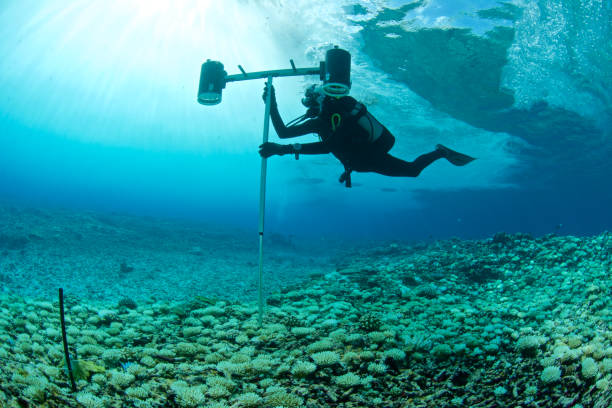
marine biologist surveys bleached coral
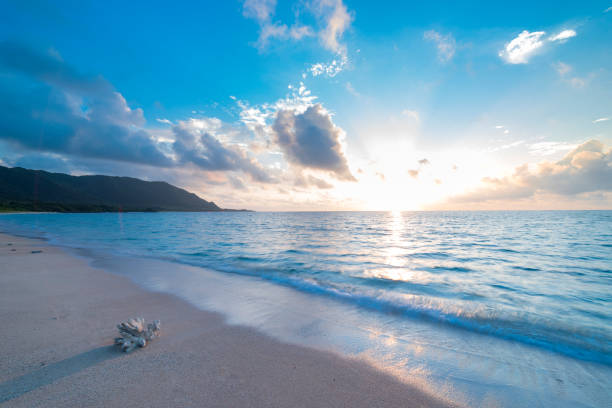
A sunrise view of the Pacific Ocean from the east coast area of Ishigaki Island, Okinawa Perfecture

Coral reefs are the one of earths most complex ecosystems, containing over 800 species of corals and one million animal and plant species. Here we see a shallow coral reef consisting of hard Staghorn Coral (Acropora) supporting shoals of Indian Damselfish (Dascyllus cameus). They are using the reef as a natural protection from predators. This coral, although on the whole healthy, is showing signs of distress. 75% of the worlds coral reefs are now classed as 'Threatened,' with 60% of most reefs having local damage from anchors, overfishing, coral bleaching, disease and pollution. Here the tips of the coral are beginning to bleach.
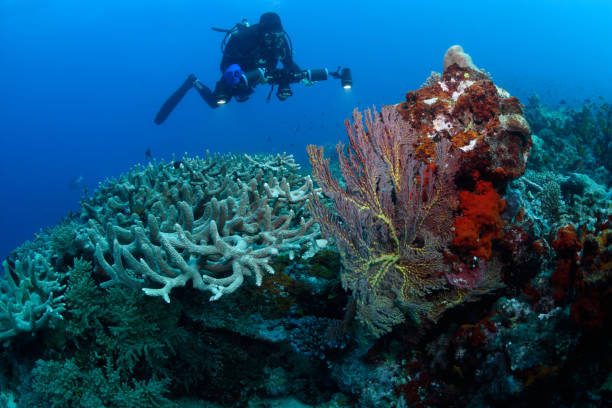
A diver videos rich and healthy hard corals uneffected after recent coral bleaching events, Far Northern Reefs, Great Barrier Reef, Queensland, Australia, Coral Sea, South Pacific Ocean

Bleached pocillopora on coral reef in Seychelles, coral bleaching. with copy space

Underwater Seascape, Coral Reef, Red Sea, Egypt, Africa

The remnants of a coral reef, destroyed by a bleaching event caused by warm sea temperatures, is now substrate for algae and sponges. Dead coral reefs lose their previous biodiversity.

Coral bleaching, bleached Pocillopora coral in shallow water due to El Nino, south Pacific ocean, French Polynesia, Oceania

Close up of a scuba diver holding an underwater camera with two lights facing the camera to a dying red gorgonian coral in the mediterranean sea

Decorative white coral branch texture, close-up shot, selective focus, abstract natural sea life background

Coral head on the Great Barrier Reef with fish

devastating coral bleaching due to global warming. These corals are dying.
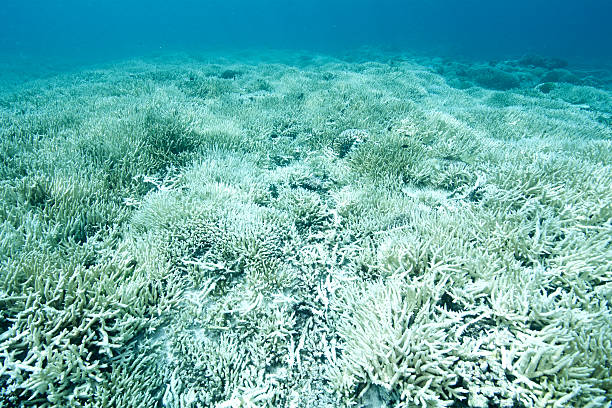
devastating coral bleaching due to global warming. These corals are dying.

Hard corals bleaching due to high water temperature

The hairdresser is coloring the client's hair. Lightening of hair roots. Applying a lightener with a brush to the strands of hair. Beauty salon or Home hair coloring

Closeup of a piece of white coral, bleached and dead. Soft focus stone background.

Small, healthy corals are beginning to grow on a reef in Indonesia that was destroyed by storm damage. Given time, coral reefs can regenerate if the local area is not polluted and overfished.

This stunning Staghorn coral ((Acropora cervicornis) is showing early signs of coral bleaching as the tips are turning white. This is a critically endangered species of coral highly sensitive to pollution, climate change, ocean acidification and disease as its threats. Coral reefs are some of the most diverse ecosystems in the world with 70% globally suffering coral bleaching. The location is Phi Phi Islands, Andaman Sea, Krabi, Thailand.

This image shows the devastating effects of Coral bleaching as a result of global warming and ocean acidification. Where there once was a large area of healthy stag horn coral, now there is only the skeletal remains. In the middle stands one last coral, a Magnificent Sea Anemone (***). These corals are dead due to the ocean temperature rising and causing loss of endosymbiotic algae from the coral. Here we see an example of the underwater effects on this coral reef ecosystem being devastated. Image obtained whilst scuba diving at Phi Phi islands, Andaman sea, Krabi, Thailand.

Coral reefs are the one of earths most complex ecosystems, containing over 800 species of corals and one million animal and plant species. Here we see a shallow coral reef with a Finger coral (Stylophora pistillata) that is completely bleached white. Coral bleaching occurs when corals are distressed and dying due to the ocean temperature rising. This stress causes them to expel endosymbiotic algae leaving only the dead skeleton. Image obtained whilst scuba diving at Phi Phi, Krabi province, Thailand.